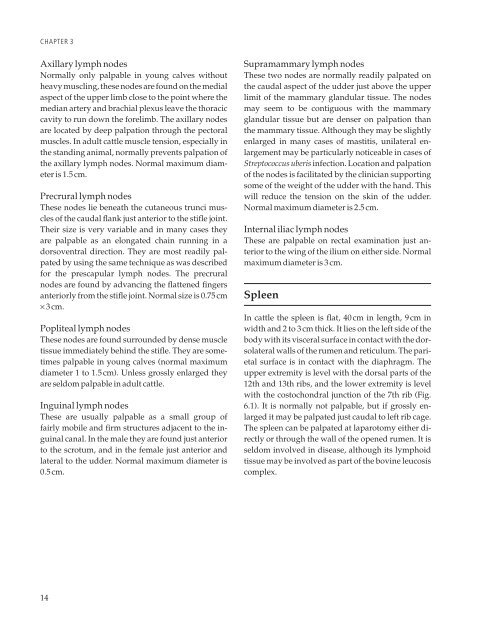Clinical Examination of Farm Animals - CYF MEDICAL DISTRIBUTION
Clinical Examination of Farm Animals - CYF MEDICAL DISTRIBUTION
Clinical Examination of Farm Animals - CYF MEDICAL DISTRIBUTION
You also want an ePaper? Increase the reach of your titles
YUMPU automatically turns print PDFs into web optimized ePapers that Google loves.
CHAPTER 1<br />
Table 1.1 The clinical examination<br />
Owner’s complaint<br />
Signalment <strong>of</strong> the patient<br />
History <strong>of</strong> the patient(s)<br />
History <strong>of</strong> the farm<br />
Observation <strong>of</strong> the environment<br />
Observation <strong>of</strong> the animal at a distance<br />
Detailed observations <strong>of</strong> the animal<br />
<strong>Examination</strong> <strong>of</strong> the animal<br />
Further investigations<br />
Observation <strong>of</strong> the environment<br />
The environment in which the animals were kept<br />
at the time <strong>of</strong> the onset or just before the onset <strong>of</strong> the<br />
illness should be carefully examined. The animals<br />
may be housed or outside. Risk factors outdoors<br />
may include the presence <strong>of</strong> toxic material, grazing<br />
management, biosecurity and regional mineral<br />
deficiencies. Risk factors indoors may include ventilation,<br />
humidity, dust, stocking density, temperature,<br />
lighting, bedding, water availability, feeding<br />
facilities and fitments.<br />
Observation <strong>of</strong> the animal at a distance<br />
History <strong>of</strong> the patient(s)<br />
Disease information<br />
Disease information should include the group(s)<br />
affected, the numbers <strong>of</strong> animal affected (morbidity)<br />
and the identities <strong>of</strong> the animals affected; the number<br />
<strong>of</strong> animals that have died (mortality) should be<br />
established. Information regarding the course <strong>of</strong><br />
the disease should be obtained including the signs<br />
observed.<br />
Risk factors<br />
Possible predisposing risk factors should be identified.<br />
These may include the origin <strong>of</strong> the stock,<br />
current disease control programmes (vaccination,<br />
anthelmintic programmes, biosecurity) and<br />
nutrition.<br />
Response to treatment<br />
<strong>Clinical</strong> improvement following treatment may<br />
support a tentative diagnosis.<br />
History <strong>of</strong> the farm<br />
The disease history <strong>of</strong> the farm will indicate diseases<br />
that should be considered carefully and may<br />
indicate some <strong>of</strong> the local disease risk factors operating.<br />
The sources <strong>of</strong> information may include farm<br />
records, practice records, colleagues and the owner.<br />
Husbandry standards, production records, biosecurity<br />
protocols, vaccination and anthelmintic<br />
programmes may all be relevant.<br />
Ideally this procedure should be performed with the<br />
patient in its normal environment. This enables its<br />
behaviour and activities to be monitored without<br />
restraint or excitement. These can be compared with<br />
those <strong>of</strong> other member <strong>of</strong> the group and relative to<br />
accepted normal patterns. However, sick animals<br />
have <strong>of</strong>ten been separated from their group and assembled<br />
in collecting yards or holding pens awaiting<br />
examination. Observations are most frequently<br />
made in this situation; they may include feeding,<br />
eating, urinating, defaecation, interactions between<br />
group members and responses to external stimuli.<br />
The patient can be made to rise and walk. The posture,<br />
contours and gait can be assessed, and gross<br />
clinical abnormalities detected.<br />
Useful information is <strong>of</strong>ten derived from these<br />
observations and this stage in the clinical examination<br />
should not be hurried.<br />
Detailed observations <strong>of</strong> the animal<br />
Detailed observations can be made in docile animals<br />
without restraint; however, restraint may be necessary<br />
to facilitate this procedure. Closer observation<br />
<strong>of</strong> the patient may detect smaller and more subtle<br />
abnormalities.<br />
<strong>Examination</strong> <strong>of</strong> the animal<br />
Restraint is usually necessary for the examination<br />
and to ensure the safety <strong>of</strong> the animal and<br />
clinician.<br />
4













